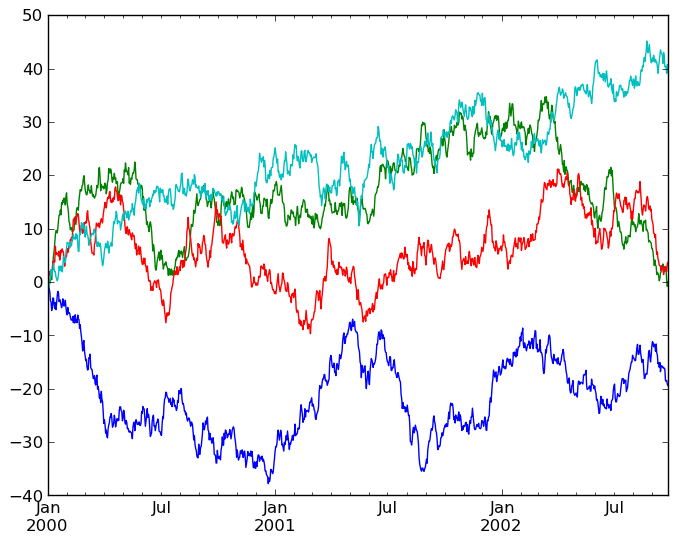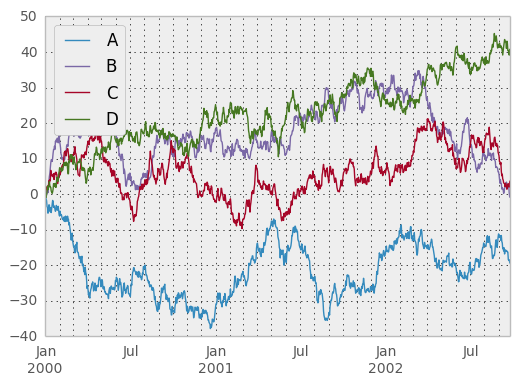44 pandas series get labels
Python Pandas Series - javatpoint The Pandas Series can be defined as a one-dimensional array that is capable of storing various data types. We can easily convert the list, tuple, and dictionary into series using " series ' method. The row labels of series are called the index. A Series cannot contain multiple columns. It has the following parameter: How to get the index and values of series in Pandas? A pandas Series holds labeled data, by using these labels we can access series elements and we can do manipulations on our data. However, in some situations, we need to get all labels and values separately. Labels can be called indexes and data present in a series called values. If you want to get labels and values individually.
how to Access the elements of a Series in python - pandas Accessing data from series with Labels or index: A Series is like a fixed-size dictionary in that you can get and set values by index label. Retrieve a single element using index label: 1 2 3 4 5 6 7 8 # create a series import pandas as pd import numpy as np data = np.array ( ['a','b','c','d','e','f'])

Pandas series get labels
Pandas: Get label for value in Series Object - Stack Overflow You can get the subseries by: In [90]: s[s==12] Out[90]: d 12 dtype: int64 Moreover, you can get those labels by. In [91]: s[s==12].index Out[91]: Index([d], dtype=object) Python | Pandas Series.get() - GeeksforGeeks Example #1: Use Series.get () function to get the value for the passed index label in the given series object. import pandas as pd sr = pd.Series ( ['New York', 'Chicago', 'Toronto', None, 'Rio']) index_ = ['City 1', 'City 2', 'City 3', 'City 4', 'City 5'] sr.index = index_ print(sr) Output : Python | Pandas Series - Tutorialspoint.dev Pandas Series is a one-dimensional labeled array capable of holding data of any type (integer, string, float, python objects, etc.). The axis labels are collect ... In order to access an element from series, we have to set values by index label. A Series is like a fixed-size dictionary in that you can get and set values by index label.
Pandas series get labels. How to print x-axes labels in pandas.Series.plot()? Having a look at the Pandas plot method (on the DataFrame object), we can see that it returns a matplotlib Axes object. Try something like this: ax = df.groupby ('owner_team').inc_subj.count ().plot.bar (ylim=0) ax.set_xticklabels (df.owner_team) # if they are still present as strings pandas Tutorial => Select column by label Filtering columns (selecting "interesting", dropping unneeded, using RegEx, etc.) Get the first/last n rows of a dataframe. Mixed position and label based selection. Path Dependent Slicing. Select by position. Select column by label. Select distinct rows across dataframe. Slicing with labels. IO for Google BigQuery. Pandas Select Rows by Index (Position/Label) To select the rows, the syntax is df.loc [start:stop:step]; where start is the name of the first-row label to take, stop is the name of the last row label to take, and step as the number of indices to advance after each extraction; for example, you can use it to select alternate rows. Python | Pandas Series.keys() - GeeksforGeeks Pandas series is a One-dimensional ndarray with axis labels. The labels need not be unique but must be a hashable type. The object supports both integer- and label-based indexing and provides a host of methods for performing operations involving the index. Pandas Series.keys() function is an alias for index. It returns the index labels of the given series object.
Pandas DataFrame loc[] to access a group of Rows and Columns A Single Label - returning the row as Series object. A list of Labels - returns a DataFrame of selected rows. A Slice with Labels - returns a Series with the specified rows, including start and stop labels. A boolean array - returns a DataFrame for True labels, the length of the array must be the same as the axis being selected. 7 Reindexing and altering labels — Pandas Doc - GitHub Pages reindex () is the fundamental data alignment method in pandas. It is used to implement nearly all other features relying on label-alignment functionality. To reindex means to conform the data to match a given set of labels along a particular axis. This accomplishes several things: Reorders the existing data to match a new set of labels pandas/series.py at main · pandas-dev/pandas · GitHub One-dimensional ndarray with axis labels (including time series). Labels need not be unique but must be a hashable type. The object: supports both integer- and label-based indexing and provides a host of: methods for performing operations involving the index. Statistical: methods from ndarray have been overridden to automatically exclude pandas.Series — pandas 1.4.3 documentation Invoke function on values of Series. argmax ( [axis, skipna]) Return int position of the largest value in the Series. argmin ( [axis, skipna]) Return int position of the smallest value in the Series. argsort ( [axis, kind, order]) Return the integer indices that would sort the Series values.
Labeling your axes in pandas and matplotlib Specify axis labels with pandas. When you plot, you get back an ax element. It has a million and one methods, two of which are set_xlabel and set_ylabel. # Draw a graph with pandas and keep what's returned ax = df. plot (kind = 'scatter', x = 'GDP_per_capita', y = 'life_expectancy') # Set the x scale because otherwise it goes into weird negative numbers ax. set_xlim ((0, 70000)) # Set the x ... Create a Pie Chart of Pandas Series Values - Data Science Parichay First, we'll create a sample pandas series which we will be using throughout this tutorial. import pandas as pd # pandas series Wimbledon winners from 2015 to 2019 wimbledon_winners = pd.Series(index=[2015, 2016, 2017, 2018, 2019], data=['Novak Djokovic', 'Andy Murray', 'Roger Federer', 'Novak Djokovic', 'Novak Djokovic'], name='Winners') Pandas Series: idxmax() function - w3resource Get the row label of the maximum value in Pandas series . The idxmax() function is used to get the row label of the maximum value. If multiple values equal the maximum, the first row label with that value is returned. Syntax: Series.idxmax(self, axis=0, skipna=True, *args, **kwargs) Parameters: Name Description Python Pandas - Series - tutorialspoint.com import pandas as pd s = pd.Series([1,2,3,4,5],index = ['a','b','c','d','e']) #retrieve the last three element print s[-3:] Its output is as follows −. c 3 d 4 e 5 dtype: int64 Retrieve Data Using Label (Index) A Series is like a fixed-size dict in that you can get and set values by index label. Example 1
A Practical Introduction to Pandas Series | by B. Chen - Medium A practical introduction to Pandas Series (Image by Author using canva.com). DataFrame and Series are two core data structures in Pandas.DataFrame is a 2-dimensional labeled data with rows and columns. It is like a spreadsheet or SQL table. Series is a 1-dimensional labeled array. It is sort of like a more powerful version of the Python list.Understanding Series is very important, not only ...
Pandas Lesson 1: Series - Practical Data Science An important property of index labels is that they stay with each row, even if you sort your data. So if I sort my Series by attendance, not only will rows re-order, but so will the index labels: [4]: attendance = attendance.sort_values() attendance [4]: Thursday 84 Tuesday 94 Wednesday 112 Monday 132 Friday 254 Saturday 322 Sunday 472 dtype: int64
Pandas Series - W3Schools Create Labels With the index argument, you can name your own labels. Example Create you own labels: import pandas as pd a = [1, 7, 2] myvar = pd.Series (a, index = ["x", "y", "z"]) print(myvar) Try it Yourself » When you have created labels, you can access an item by referring to the label. Example Return the value of "y": print(myvar ["y"])
How to get the names (titles or labels) of a pandas data ... - MoonBooks To get the names of the data frame rows: >>> df.index Index(['Alice', 'Bob', 'Emma'], dtype='object') Get the row names of a pandas data frame (Exemple 2) Another example using the csv file train.csv (that can be downloaded on kaggle): >>> import pandas as pd >>> df = pd.read_csv('train.csv') >>> df.index RangeIndex(start=0, stop=1460, step=1)
Labeling Data with Pandas - Medium We will label the data with a '1' if the alcohol % is above or equal to 10% and '0' otherwise: import numpy as np df_wine ['alcohol_class'] = np.where (df_wine ['alcohol']>=10.0, '1', '0') We can now visualize the distribution in binary labels: from collections import Counter plt.title ("Distribution in Alcohol Class Labels")
pandas: Extract rows/columns from DataFrame according to labels | note ... How to use pandas.DataFrame.filter() The axis to filter on: axis; Exact match: items; Partial match: like; Regular expression: regex; For pandas.Series; See the following article for the basics of selecting rows and columns in pandas. pandas: Select rows/columns in DataFrame by indexing "[]" pandas: Get/Set element values with at, iat, loc, iloc
Convert pandas.DataFrame, Series and list to each other After generating pandas.DataFrame and pandas.Series, you can set and change the row and column names by updating the index and columns attributes.. pandas: Rename columns/index names (labels) of DataFrame; For list containing data and labels (row/column names) Here's how to generate pandas.Series from a list of label and value pairs.. Break it down into a list of labels and a list of values ...






Post a Comment for "44 pandas series get labels"